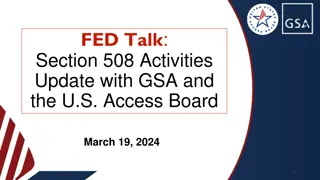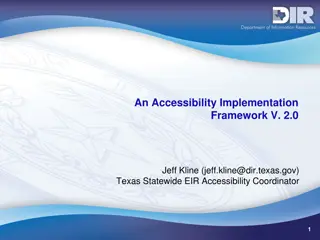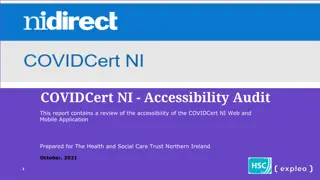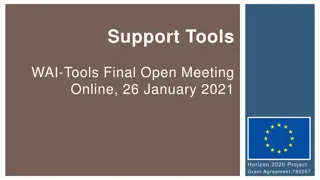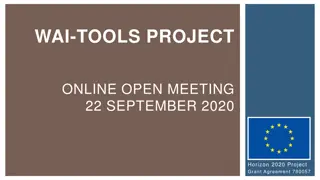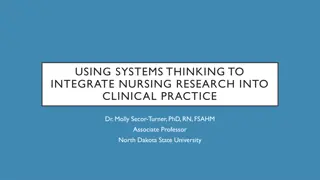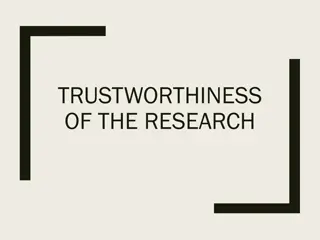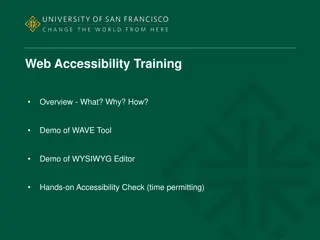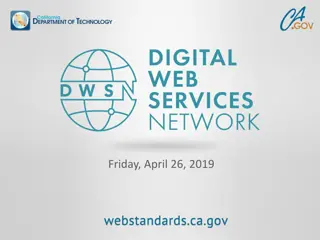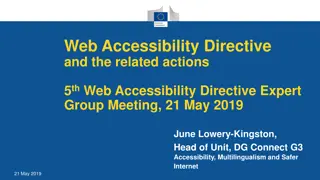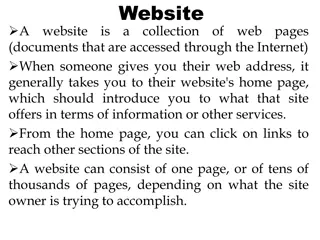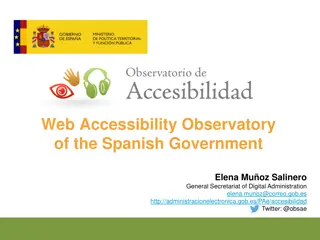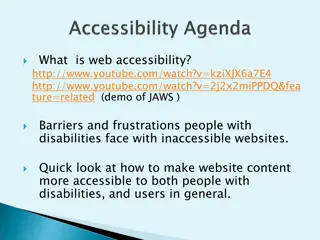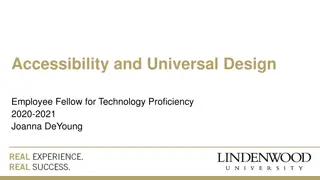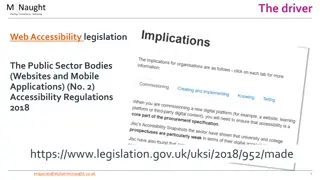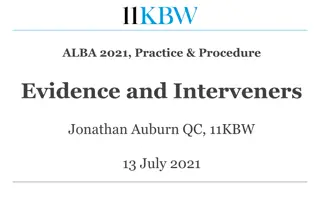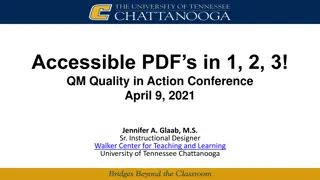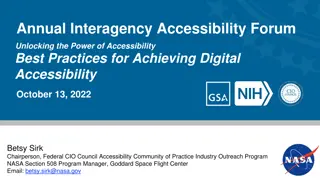Evaluating Trustworthiness and Accessibility of Evidence-Based Practice Websites
This paper discusses the importance of using online resources for accessing evidence-based instructional practices in education. It highlights the challenges educators face in finding trustworthy and accessible websites for reliable information. The session goals include providing administrators with tools to evaluate websites and identify high-quality resources. Trustworthiness and accessibility criteria are examined, emphasizing the need for practitioners to have confidence in the research and ease of finding and implementing evidence-based practices.
Download Presentation

Please find below an Image/Link to download the presentation.
The content on the website is provided AS IS for your information and personal use only. It may not be sold, licensed, or shared on other websites without obtaining consent from the author. Download presentation by click this link. If you encounter any issues during the download, it is possible that the publisher has removed the file from their server.
E N D
Presentation Transcript
2015 Leadership Conference All In: Achieving Results Together 2015 Leadership Conference All In: Achieving Results Together Are Evidence-Based Practice Websites Trustworthy and Accessible? David W. Test University of North Carolina at Charlotte Paper presented at the OSEP Leadership Conference, July 28, 2015, Washington, DC.
Session Goals This session will provide administrators with a starter list of websites that can be trusted to contain high-quality resources teachers can use to learn about and use evidence-based instructional practices, as well as a simple, four- step process for evaluating other websites.
Evidence-based Education Integration of stakeholder values, practitioner expertise, and the best available evidence Evidence-based practices (EBPs) are practices supported by the best available evidence used in evidence-based education EBPs are instructional practices shown to be generally effective (for a population of learners in an outcome area) by a body of high-quality, experimental research studies
Why Use Online Resources? While professional journals include reviews that identify EBPs, Beach et al. (2007) found teachers seldom read these journals. Twyman and Sota (2008) and Kretlow and Blatz (2011) suggested educators use the Internet to access information about EBPs. Jones (2009) found all participants in her study used the Internet as a major source for information to improve their classroom instruction. Although numerous websites claim to provide consumers with information about EBPs, only a few are trustworthy and accessible
Trustworthiness (Carnine, 1997) The degree to which practitioners can have confidence in quality of the research and findings. Evaluated by examining the research methodology according to specific quality indicators (e.g., demonstrating use of appropriate research design, socially-valid research questions, adequate replication). IES/WWC standards CEC standards Campbell Collaborative NSTTAC/NTACT standards National Autism Center standards
Accessibility (Carnine, 1997) The ease with which educators can find and use information to implement an evidence-based practice. Ease of navigation, defined as the number of navigational clicks necessary to locate an EBP; Type of implementation materials, meaning a website had: (a) clear descriptions of EBPs (e.g., overview, systematic reviews, fact sheets, EBP briefs); (b) resources to teach practitioners how to implement the practice with fidelity (e.g., learning modules, webinars); and (c) materials for classroom application (e.g., downloadable materials, lesson plans, task analysis for EBP, data collection sheets).
Four Steps to Simplify the EBP Search Process 1. Does the site claim to have evidence-based practices? If yes, the site references research move to step 2 2. Does it link to research, provide articles or links that demonstrate the effectiveness of the intervention through measures of credible, reliable evidence (i.e., What Works Clearinghouse, NSTTAC, RTI, Horner/Gersten)? If yes, move to step 3 3. Are the practices easily accessible and require minimal navigation (three or fewer clicks)? If yes, move to step 4 4. Are there clear descriptions of practices and a variety of implementation materials for teachers and students for downloading? If yes, try it, but collect student data to see if it works!
If you do not have time to do steps 1-4, start with this list Websites Types of Practices Trustworthiness (Trust rating) Accessibility: Ease of Navigation Accessibility: Types of Implementation http://www.3cisd.com 3-C Institute for Social Development http://www.3cisd.com Social skills, literacy, behavioral (R) ($) www.centeroninstruction.org Center on Instruction www.centeroninstruction.org Literacy, STEM ELL, RTI Center on Positive Behavioral Interventions and Supports www.pbis.org Behavioral www.pbis.org Center on the Social and Emotional Behavioral, social skills, communication http://csefel.vanderbilt.edu Foundations for Early Learning http://csefel.vanderbilt.edu Literacy and reading http://www.fcrr.org/ Florida Center for Reading Research http://www.fcrr.org/ National Center on Intensive Intervention at Academic and behavioral www.intensiveintervention.org American Institutes for Research www.intensiveintervention.org Note: (R) = Need to register on website to attain EBP information, ($) = Need to pay for EBP information.
this list continues Websites Types of Practices Trustworthiness (Trust rating) Accessibility: Ease of Navigation Accessibility: Types of Implementation National Secondary Transition Technical Assistance Center www.nsttac.org Secondary transition www.nsttac.org www.readingrockets.org Reading Rockets www.readingrockets.org Literacy, ELLs, technology http://iris.peabody.vanderbilt.edu/ebp/ The IRIS Center http://iris.peabody.vanderbilt.edu/ebp/ Academic, assessment, behavior, secondary transition Academic and behavioral The National Center on Response to Intervention www.rti4success.org www.rti4success.org Communication, social skills, behavioral, technology-aided interventions, systematic instruction, visual supports The National Professional Development http://autismpdc.fpg.unc.edu/ Center on Autism Spectrum Disorders http://autismpdc.fpg.unc.edu/ (R) Note: (R) = Need to register on website to attain EBP information, ($) = Need to pay for EBP information.
Thank You! David Test University of North Carolina at Charlotte dwtest@uncc.edu


